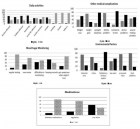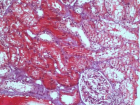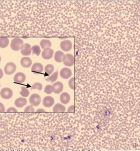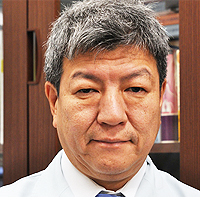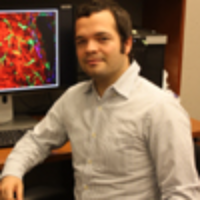Abstract
Research Article
Cloning and Characterization of a Pseudo-Response Regulator 7 (PRR7) Gene from Medicago Sativa Involved In Regulating the Circadian Clock
Weifeng Nian* and Yilin Shen
Published: 16 July, 2019 | Volume 3 - Issue 2 | Pages: 056-061
The circadian clock is an endogenous molecular oscillator with a period of about 24 hours, which regulates the physiology and developmental processes of almost all higher plants. Pseudo-response regulators (PRRs) are an important part of the central clock oscillator, together with other clock genes, constituting interlinked transcriptional feedback loops, which partly influence plant growth and development. In this study, a circadian clock-related gene MsPRR7 was cloned from Medicago sativa (alfalfa) by homologous cloning. The full length MsPRR7 gene was 2648 bp in length, with an open reading frame of 2385 bp encoding a protein of 795amino acids. Phylogenetic analysis showed that the MsPRR7 was closely related to PRR7 from the PRR family of Arabidopsis thaliana. Subcellular localization analysis found that MsPRR7 was located in the nucleus. Quantitative reverse-transcription polymerase chain reactions (qRT-PCR) demonstrated that expression of MsPRR7 gene transcripts in leaves was affected by circadian rhythms, and that its expression level increased with an extension of illumination time, reaching a peak around 8–10 hours. These results will provide the experimental basis for further study of the regulation of PRR family genes in alfalfa.
Read Full Article HTML DOI: 10.29328/journal.jpsp.1001032 Cite this Article Read Full Article PDF
References
- Srikanth A, Schmid M: Regulation of flowering time: all roads lead to Rome, Cell Mol Life Sci. 2011; 68: 2013-2037. PubMed: https://www.ncbi.nlm.nih.gov/pubmed/21611891
- Pittendrigh CS: Circadian rhythms and the circadian organization of living systems, Cold Spring Harb SympQuant Biol. 1960; 25: 159-184. PubMed: https://www.ncbi.nlm.nih.gov/pubmed/13736116
- Pittendrigh CS: Circadian surfaces and the diversity of possible roles of circadian organization in photoperiodic induction, Proc Natl Acad Sci USA. 1972; 69: 2734-2737. PubMed: https://www.ncbi.nlm.nih.gov/pmc/articles/PMC427028/
- Wang ZY, Tobin EM: Constitutive expression of the CIRCADIAN CLOCK ASSOCIATED 1 (CCA1) gene disrupts circadian rhythms and suppresses its own expression, Cell. 1998; 93: 1207-1217. PubMed: https://www.ncbi.nlm.nih.gov/pubmed/9657153
- Alabadí D, Yanovsky MJ, Más P, Harmer SL, Kay SA. Critical role for CCA1 and LHY in maintaining circadian rhythmicity in Arabidopsis, Curr Biol. 2002; 12: 757-761. PubMed: https://www.ncbi.nlm.nih.gov/pubmed/12007421
- Mizoguchi T, Wheatley K, Hanzawa Y, Wright L, Mizoguchi M, et al. LHY and CCA1 are partially redundant genes required to maintain circadian rhythms in Arabidopsis. Dev Cell. 2002; 2: 629-641. PubMed: https://www.ncbi.nlm.nih.gov/pubmed/12015970
- Mizuno T, Nakamichi N. Pseudo-Response Regulators (PRRs) or True Oscillator Components (TOCs). Plant Cell Physiol. 2005; 46: 677-685. PubMed: https://www.ncbi.nlm.nih.gov/pubmed/15767264
- Matsushika A, Makino S, Kojima M, Mizuno T. Circadian waves of expression of the APRR1/TOC1 family of pseudo-response regulators in Arabidopsis thaliana: insight into the plant circadian clock. Plant Cell physiol. 2000; 41: 1002-1012. PubMed: https://www.ncbi.nlm.nih.gov/pubmed/11100772
- Murakami M, Ashikari M, Miura K. The evolutionarily conserved OsPRR quintet: rice pseudo-response regulators implicated in circadian rhythm. Plant Cell physiol. 2003; 44: 1229-1236.
- Michael TP, Mockler TC, Breton G, McEntee C, Byer A, et al. Network discovery pipeline elucidates conserved time-of-day-specific cis-regulatory modules. Plos Genet. 2008; 4: 14. PubMed: https://www.ncbi.nlm.nih.gov/pubmed/18248097
- Hazen SP, Naef F, Quisel T. Exploring the transcriptional landscape of plant circadian rhythms using genome tiling arrays, Genome Biol. 2009; 10: 17.
- Fukushima A, Kusano M, Nakamichi N, Kobayashi M, Hayashi N, et al. Impact of clock-associated Arabidopsis pseudo-response regulators in metabolic coordination. Proc Natl Acad Sci USA. 2009; 106: 7251-7256. PubMed: https://www.ncbi.nlm.nih.gov/pubmed/19359492
- Farré EM, Harmer SL, Harmon FG, Yanovsky MJ, Kay SA. Overlapping and distinct roles of PRR7 and PRR9 in the Arabidopsis circadian clock. Curr Biol. 2005; 15: 47-54. PubMed: https://www.ncbi.nlm.nih.gov/pubmed/15649364
- Yamaguchi A, Kobayashi Y, Goto K, Abe M, Araki T. TWIN SISTER OF FT (TSF) acts as a floral pathway integrator redundantly with FT. Plant Cell Physiol. 2005; 46: 1175-1189.PubMed: https://www.ncbi.nlm.nih.gov/pubmed/15951566
- Kolmos E, Chow BY, Pruneda-Paz JL, Kay SA. HsfB2b-mediated repression of PRR7 directs abiotic stress responses of the circadian clock. Proc Natl Acad Sci USA. 2014; 111: 16172-16177. PubMed: https://www.ncbi.nlm.nih.gov/pubmed/25352668
- Gao H, Jin M, Zheng XM, Chen J, Yuan D, et al. Days to heading 7, a major quantitative locus determining photoperiod sensitivity and regional adaptation in rice, Proc Natl Acad Sci USA. Correction. 2014; 111: 16337–16342. PubMed: https://www.ncbi.nlm.nih.gov/pubmed/25378698
- Yang S, Murphy RL, Morishige DT, Klein PE, Rooney WL, et al. Sorghum phytochrome B inhibits flowering in long days by activating expression of SbPRR37 and SbGHD7, repressors of SbEHD1, SbCN8 and SbCN12. Plos One. 2014; 9: 105352. PubMed: https://www.ncbi.nlm.nih.gov/pmc/articles/PMC4133345/
- Turner A, Beales J, Faure S, Dunford RP, Laurie DA. The pseudo-response regulator Ppd-H1 provides adaptation to photoperiod in barley. Science. 2005; 310: 1031-1034. PubMed: https://www.ncbi.nlm.nih.gov/pubmed/16284181
- Zhang W, Zhao G, Gao L, Kong X, Guo Z, et al. Functional studies of heading date-related geneTaPRR73, a paralog ofPpd1in common wheat. Front Plant Sci. 2016; 7: 772. PubMed: https://www.ncbi.nlm.nih.gov/pubmed/27313595
- Digel B, Tavakol E, Verderio G, Tondelli A, Xu X, et al.: Photoperiod-H1 (Ppd-H1) controls leaf size. Plant Physiol. 2016; 172: 405-415. PubMed: https://www.ncbi.nlm.nih.gov/pubmed/27457126
- Jung C, Müller AE. Flowering time control and applications in plant breeding. Trends Plant Sci. 2009; 14: 563-573. PubMed: https://www.ncbi.nlm.nih.gov/pubmed/19716745
- Sparkes IA, Runions J, Kearns A, Hawes C. Rapid, transient expression of fluorescent fusion proteins in tobacco plants and generation of stably transformed plants. Nature Protocols. 2006; 1: 2019-2025. PubMed: https://www.ncbi.nlm.nih.gov/pubmed/17487191
- Sato E, Nakamichi N, Yamashino T, Mizuno T. Aberrant expression of the Arabidopsis circadian-regulated APRR5 gene belonging to the APRR1/TOC1 quintet results in early flowering and hypersensitiveness to light in early photomorphogenesis. Plant Cell Physiol. 2002; 43: 1374-1385. PubMed: https://www.ncbi.nlm.nih.gov/pubmed/12461138
- Makino S, Kiba T, Imamura A, Hanaki N, Nakamura A, et al. Genes encoding pseudo-response regulators: insight into His-to-Asp phosphorelay and circadian rhythm in Arabidopsis thaliana. Plant Cell Physiol. 2000; 41: 791-803. PubMed: https://www.ncbi.nlm.nih.gov/pubmed/10945350
- Matsushika A, Imamura A, Yamashino T, Mizuno T. Aberrant expression of the light-inducible and circadian-regulated APRR9 Gene belonging to the circadian-associated APRR1/TOC1 quintet results in the phenotype of early flowering in Arabidopsis thaliana, Plant Cell Physiol. 2002; 43: 833-843. PubMed: https://www.ncbi.nlm.nih.gov/pubmed/12198185
Figures:
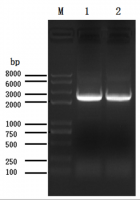
Figure 1
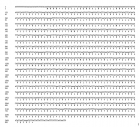
Figure 2
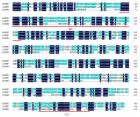
Figure 3

Figure 4
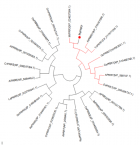
Figure 5
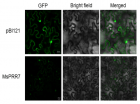
Figure 6
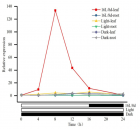
Figure 7
Similar Articles
-
Impact of Calcium Phosphate Nanoparticles on Rice PlantHrishikesh Upadhyaya*,Lutfa Begum,Bishal Dey,P K Nath,S K Panda. Impact of Calcium Phosphate Nanoparticles on Rice Plant. . 2017 doi: 10.29328/journal.jpsp.1001001; 1: 001-010
-
The Effects of Pharmacological Carbonic Anhydrase Suppression on Defence Responses of Potato Leaves To Phytophthora InfestansMagdalena Arasimowicz-Jelonek*,Jolanta Floryszak-Wieczorek. The Effects of Pharmacological Carbonic Anhydrase Suppression on Defence Responses of Potato Leaves To Phytophthora Infestans. . 2017 doi: 10.29328/journal.jpsp.1001002; 1: 011-025
-
Phytochemical content of leaf and stem of Marsilea quadrifolia (L.)Rajangam Udayakumar*,Karikalan Gopalakrishnan. Phytochemical content of leaf and stem of Marsilea quadrifolia (L.). . 2017 doi: 10.29328/journal.jpsp.1001003; 1: 026-037
-
Antagonistic features displayed by Plant Growth Promoting Rhizobacteria (PGPR): A ReviewMohsin Tariq*,Muhammad Noman,Temoor Ahmed,Amir Hameed,Natasha Manzoor,Marriam Zafar. Antagonistic features displayed by Plant Growth Promoting Rhizobacteria (PGPR): A Review . . 2017 doi: 10.29328/journal.jpsp.1001004; 1: 038-043
-
Wild-type Agrobacterium rhizogenes-mediated gene transfer in plants: Agrobacterium virulence and selection of transformantsShu Wei*,Muhammad Abdullah,Ferdinand L Shamalla,Mohammad M Rana. Wild-type Agrobacterium rhizogenes-mediated gene transfer in plants: Agrobacterium virulence and selection of transformants. . 2017 doi: 10.29328/journal.jpsp.1001005; 1: 044-051
-
Effects of Vochysia haenkeana extract on the neuromuscular blockade induced by Bothrops jararaca venom on chick biventer cervicis preparation in vitroYoko Oshima-Franco*,Fernanda Dias da Silva,Natália Tribuiani,Isadora Caruso Fontana Oliveira,Regina Yuri Hashimoto Miura,Rafael S Floriano,Márcio Galdino dos Santos,Sandro Rostelato-Ferreira. Effects of Vochysia haenkeana extract on the neuromuscular blockade induced by Bothrops jararaca venom on chick biventer cervicis preparation in vitro. . 2017 doi: 10.29328/journal.jpsp.1001006; 1: 052-058
-
HBV: Genomic Structure, HBVsAg Isolation and innovative Virotherapy Initiation in the Middle EastAboul-Ata E Aboul-Ata*,Essam M Janahi,I M El-Kalamawy,Kathleen Hefferon,Amal Mahmoud. HBV: Genomic Structure, HBVsAg Isolation and innovative Virotherapy Initiation in the Middle East . . 2017 doi: 10.29328/journal.jpsp.1001007; 1: 059-061
-
Physiological impact of Zinc nanoparticle on germination of rice (Oryza sativa L) seedUpadhyaya H*,Roy H,Shome S,Tewari S,Bhattacharya MK,Panda SK. Physiological impact of Zinc nanoparticle on germination of rice (Oryza sativa L) seed . . 2017 doi: 10.29328/journal.jpsp.1001008; 1: 062-070
-
Effects of Site Factors on the Clonal Growth of Phyllostachys bambusoides f. shouzhu YiXiaohong Gan*,Lijuan Chen,Cuibin Tang,Xia Zhang. Effects of Site Factors on the Clonal Growth of Phyllostachys bambusoides f. shouzhu Yi. . 2017 doi: 10.29328/journal.jpsp.1001009; 1: 071-079
-
Evaluation of genetic diversity in germplasm of paprika (Capsicum spp.) using random amplified polymorphic DNA (RAPD) markersRueda-Puente EO*,Renganathan P,Ruíz-Alvarado C,Hernández-Montiel LG,Prasath Duraisamy. Evaluation of genetic diversity in germplasm of paprika (Capsicum spp.) using random amplified polymorphic DNA (RAPD) markers. . 2017 doi: 10.29328/journal.jpsp.1001010; 1: 080-086
Recently Viewed
-
Pneumothorax as Complication of CT Guided Lung Biopsy: Frequency, Severity and Assessment of Risk FactorsGaurav Raj*,Neha Kumari,Neha Singh,Kaustubh Gupta,Anurag Gupta,Pradyuman Singh,Hemant Gupta. Pneumothorax as Complication of CT Guided Lung Biopsy: Frequency, Severity and Assessment of Risk Factors. J Radiol Oncol. 2025: doi: 10.29328/journal.jro.1001075; 9: 012-016
-
The Police Power of the National Health Surveillance Agency – ANVISADimas Augusto da Silva*,Rafaela Marinho da Silva. The Police Power of the National Health Surveillance Agency – ANVISA. Arch Cancer Sci Ther. 2024: doi: 10.29328/journal.acst.1001046; 8: 063-076
-
A Comparative Study of Serum Sodium and Potassium Levels across the Three Trimesters of PregnancyOtoikhila OC and Seriki SA*. A Comparative Study of Serum Sodium and Potassium Levels across the Three Trimesters of Pregnancy. Clin J Obstet Gynecol. 2023: doi: 10.29328/journal.cjog.1001137; 6: 108-116
-
Chaos to Cosmos: Quantum Whispers and the Cosmic GenesisOwais Farooq*,Romana Zahoor*. Chaos to Cosmos: Quantum Whispers and the Cosmic Genesis. Int J Phys Res Appl. 2025: doi: 10.29328/journal.ijpra.1001107; 8: 017-023
-
Phytochemical Compounds and the Antifungal Activity of Centaurium pulchellum Ethanol Extracts in IraqNoor Jawad Khadhum, Neepal Imtair Al-Garaawi*, Antethar Jabbar Al-Edani. Phytochemical Compounds and the Antifungal Activity of Centaurium pulchellum Ethanol Extracts in Iraq. J Plant Sci Phytopathol. 2024: doi: 10.29328/journal.jpsp.1001137; 8: 079-083
Most Viewed
-
Evaluation of Biostimulants Based on Recovered Protein Hydrolysates from Animal By-products as Plant Growth EnhancersH Pérez-Aguilar*, M Lacruz-Asaro, F Arán-Ais. Evaluation of Biostimulants Based on Recovered Protein Hydrolysates from Animal By-products as Plant Growth Enhancers. J Plant Sci Phytopathol. 2023 doi: 10.29328/journal.jpsp.1001104; 7: 042-047
-
Sinonasal Myxoma Extending into the Orbit in a 4-Year Old: A Case PresentationJulian A Purrinos*, Ramzi Younis. Sinonasal Myxoma Extending into the Orbit in a 4-Year Old: A Case Presentation. Arch Case Rep. 2024 doi: 10.29328/journal.acr.1001099; 8: 075-077
-
Feasibility study of magnetic sensing for detecting single-neuron action potentialsDenis Tonini,Kai Wu,Renata Saha,Jian-Ping Wang*. Feasibility study of magnetic sensing for detecting single-neuron action potentials. Ann Biomed Sci Eng. 2022 doi: 10.29328/journal.abse.1001018; 6: 019-029
-
Pediatric Dysgerminoma: Unveiling a Rare Ovarian TumorFaten Limaiem*, Khalil Saffar, Ahmed Halouani. Pediatric Dysgerminoma: Unveiling a Rare Ovarian Tumor. Arch Case Rep. 2024 doi: 10.29328/journal.acr.1001087; 8: 010-013
-
Physical activity can change the physiological and psychological circumstances during COVID-19 pandemic: A narrative reviewKhashayar Maroufi*. Physical activity can change the physiological and psychological circumstances during COVID-19 pandemic: A narrative review. J Sports Med Ther. 2021 doi: 10.29328/journal.jsmt.1001051; 6: 001-007

HSPI: We're glad you're here. Please click "create a new Query" if you are a new visitor to our website and need further information from us.
If you are already a member of our network and need to keep track of any developments regarding a question you have already submitted, click "take me to my Query."






